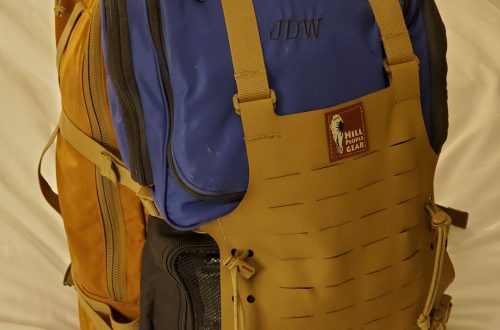London, Day 1
We made it to London this morning. We arrived an hour early (um, who thought that airlines still even tried to do that?) to London Gatwick Airport. After going through passport control, we found a manned kiosk to buy train tickets. There are a few trains from Gatwick to London stations, but only the Gatwick Express train is non-stop to Victoria Station (thanks for the tip, mr. work colleague). We got tickets for that (only about 16 Pounds each), and the kiosk guy said if we were going to be using the Underground (London’s take on the subway/metro rail system), we could get access cards for that service that came loaded with 15 Pounds, and could be “topped-up” at any station. Good deal, said we, and we got them, too.
Baggage claim was easy. Customs coming into other countries is a cinch. Nothing to declare? Go through the “nothing to declare” doorway, which just leads you to an exit. We didn’t have anything to declare, so that’s just what we did.
And there we began our first adventure. We had to get to the train platforms to get on the Gatwick Express train to London. The train ticket kiosk guy explained about going out to a free shuttle. In my mind, this mapped to something akin to the free bus-like shuttles that exist in lots of airports in the states. So, after getting our luggage, I followed the signs for the shuttle area, instead of the train area. Doh. After talking to a nice traffic cop/guard/something outside, we got straightened-out and headed where the “Trains” signs pointed us. That put us on a “free shuttle” that is exactly like the unattended shuttle that runs between the airside and terminal buildings in Pittsburgh, and that run among concourses in other large airports. Cool.
We got to the train platforms five minutes before the Gatwick Express left the station, which was good–otherwise, we’d have to wait another half-hour for the next train. We jumped on and enjoyed the ride from the slightly-more-country Gatwick area into Victoria Station. Riding through these areas, I was impressed at a few things. First, lots of communities have community garden plots, with a big plot of land divided into smaller sections that look like they are maintained by individual households. This looks to be what folks do who live in a flat without a yard (or with a yard insufficient for a garden). There were lots of well-tended gardens, though, which I thought was cool. Second, there was a definite change in landscape as we got closer to the city. The green places started to become back yards again in single-family flats, and then got smaller and smaller as we got closer to the city. Third, the train systems are completely awesome. This would have been a 100 Pound cab ride for us. Instead, 32 Pounds got us both directly from the airport to the city, and a 1 Pound 45p Underground ride got us to our hotel. Fourth, they have it together here with regards to alternative power, at least in some regards. A bunch of the train signaling systems have wind generators attached to them, and I see lots of solar panels on things. Cool stuff. Anyway, back to the adventure….
We arrived at Victoria Station with no issues. Then we had to figure out how to navigate the Underground. The online system for the Underground gave me a route to the stop near our hotel that involved a transfer. I looked at the map and realized that we could go to a station about a block in the opposite direction without having to transfer. It might take us a few extra minutes on the ride, but the distance from the hotel was the same and not having to navigate a transfer on our first Underground voyage was a good idea. Unfortunately, on our way to the platform with our luggage, we had to use our access cards (known as “Oyster” cards here, they are an RFID-based automated fare system, similar to the newer metro cards, and systems available in other large cities) to “tag-in” at the station, which opens turnstiles so that one can walk through. They have nice turnstiles for people with baggage or disabilities, so I used one of those and then turned around to make sure that Jenny was OK. She tagged-in, the door opened, and the people pushing me down the stairs to get to the waiting train dragged me away. I waited a few minutes at the platform, and there’s no Jenny. I can’t go back up the stairs that I just came down. I start looking for her on the other platform in case she didn’t see where I went, and I started to make my way over to an information desk to figure out how to get back upstairs so that I could start looking for her. Fortunately, at just about that time, I spotted her standing in another section on the same platform. I waved, she saw me, and we were good to go. We jumped on the next train in the right direction (and, fortunately, we were waiting for a Circle Line train, which quite literally goes around in a circle, so we really couldn’t have gotten on in the “wrong” direction, just in the “it’s going to take longer” direction), and arrived at the stop near our hotel in a short while.
Our hotel had our room ready, so we got straight up, unpacked, and washed-up. We took a quick nap before heading out for the afternoon. We first walked around the hotel a bit to get our bearings in the neighborhood. We saw a little Spanish cafe on a cross street, so that’s where we had lunch. It was good stuff. I had chicken in a mushroom cream sauce, and Jenny had shrimp over rice. We decided there that we were both feeling awake and ready to do some more sight-seeing, after hitting a market to grab some fruit for the room. I also decided that I wanted to put on some long pants (it’s a bit chilly here right now, and I had earlier put on shorts), and we wanted to grab our tour book to figure out where we wanted to go.
Jenny had a few things on her list of must-see London stuff, so we grabbed the guidebook and took a look at a few of them before we headed out on our adventure. Two of the things on her list were the Tower of London and the London Eye (the giant ferris wheel built for the y2k celebration). We found out that both of these, along with the Tower Bridge and a few other notable attractions, were along a river walk that followed the Thames from the Tower of London all the way to Millennium Park and the London Eye. So, with our new-found knowledge and almost-comfort of the Underground, we took to it to get to the start of this little adventure.
The walk was about two miles or so, from the Tower of London, across the Tower Bridge, and then up the Thames to Millennium park. We saw all kinds of neat things along the way, including an old covered port area that became famous as “London’s Larder,” since most of the perishable goods brought into London were brought in through this covered dock. It has been restored now, and it is quite the sight to see. It is now a patio and courtyard for a bunch of cafes and other businesses, but the cover has been restored and it just looks cool. One can almost imagine the masts of the tea clippers cruising under the canopy to unload their cargo. Neat stuff. Speaking of masts and things, Jenny and I were standing across the Tower Bridge thinking that it would have been completely awesome to see it open. Right before we turn to continue our walk, we start to hear an enormous amount of warning-siren racket from the bridge, and all of the traffic comes to a stop on both sides. We wait for a minute or so, thinking that the bridge might open, and wondering what boat would need it to open–the only thing we could see in the river was a cruise ship that wasn’t going anywhere yet. Lo and behold, the bridge began to open, and then we caught sight of a wooden gaff-rigged yawl peeking out from behind the cruise ship. It was only under motor, but it was a cool sight nonetheless. We watched it close after the ship passed, then continued on our way. We saw the Globe Theatre, another old wooden galleon reproduction, the Cathedral for the Diocese of Southwick, lots of people, and lots of history. One of the neatest things we saw, and I still don’t understand why I didn’t take a picture of it, was part of a wall that was being preserved. The wall had been part of the Bishop’s Palace in London, a retreat for bishops and a place for them to stay when they had business in London. The wall was part of the Grand Hall, and was pretty complete, up to and including the framework for the rose window. Jenny found a little plaque about it, which told us about the Grand Hall and a bit about the palace area, and also gave this tidbit of interesting information: In the 17th century, the use of the area by the bishops was discontinued, and the buildings divided into tenements. A fire in the 19th century revealed the old wall, which had been practically forgotten. A formal restoration effort began in the 1980’s, and it is continuing now. Our final destination was the London Eye, which was a great ride. Yes, it was expensive, but it was completely worth it.
We got some dinner at a place near the Eye called Giraffe’s. This is apparently a small chain in London, but it was good food. Then we departed for Waterloo station to catch the Underground back to the hotel. Of course, that was complicated by the fact that the station was under construction. Fortunately, a bunch of other people were also headed for the station (or so I guessed), so we followed them to an entrance around the side. We took the Bakerloo line back to the hotel.
Now I’m writing this. 🙂
A little while ago, Jenny decided that she couldn’t wait any longer, and we absolutely had to have tea in our room (hotels here and in other pars of Europe have a nice tea service and usually a hot-water kettle instead of the standard-issue hotel coffee pot). The service here was actually better than it had been in the Netherlands last year, so we enjoyed some good tea and talked about our adventures while the pictures were fetched from the camera to the computer. In the process of talking, Jenny reminded me that I wanted to look up why the Tower Bridge is built the way that it is. It turns out that is a pretty interesting story. In short form, there was no bridge over that section of the Thames because it was a busy shipping port. The people settling in that area of London in the late 19th century were clamoring for a bridge, so finally they built a bridge. It had to be a drawbridge, though, to accommodate shipping use of the river. It was originally designed with walkways high above the road surface, in addition to the walkways at the road surface, so that pedestrians wouldn’t have to wait for the bridge to close before continuing on their way. The elevated walkways proved so unpopular that they were eventually closed for lack of use–everyone apparently was fine standing on the ground and waiting for the bridge to close. hah.
Now it’s time for bed. I have pictures, and will upload them tomorrow.
jonathan


